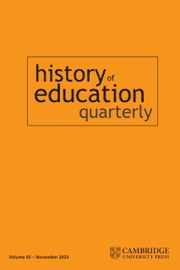The US Department of Education (USDOE) has provided federal funding for high-poverty schools since its creation, and while this funding can sometimes bridge critical gaps or support important programs, it has also been largely insufficient in addressing significant and persistent resource inequalities. Federal funding remains a key policy lever for supporting public education, as most local and state school funding formulas have led to deep imbalances, whether through reliance on property taxes or inability to address the accretion of historical disadvantages stemming from segregation, deficient infrastructure, and more.Footnote 1 Losing federal funding therefore poses the likelihood of further exacerbating profound inequities, harming the most vulnerable students in the most vulnerable schools.Footnote 2 Despite the public often assuming a large proportion of school funding comes from federal sources, that share has remained consistently below 10 percent since its inception, meaning that the lofty goals of equality advocates have often remained far out of reach.Footnote 3
In 1965, Title I, “Improving the Academic Achievement of the Disadvantaged,” was a central component of the Elementary and Secondary Education Act and the educational cornerstone of President Johnson’s War on Poverty. There was not yet a Department of Education, so the US Department of Health, Education, and Welfare’s Office of Education found itself suddenly managing a program far larger than any it had before—at first, “writing the checks” took up most of the staff’s time.Footnote 4 The first decade of Title I funding provided a novel, though small, infusion of resources directed at many of the poorest schools and students in the nation, yet just four years later the NAACP identified the many ways Title I funds were already failing to reach eligible children, meet their most serious needs, or involve parents and communities in finding solutions.Footnote 5
During the Reagan administration, Title I began to focus on tying federal evaluation and performance standards to the distribution of the program’s funds, a task made easier by the creation of the USDOE in 1980 at the tail end of the Carter administration to consolidate various federal educational programs and funding streams. In the No Child Left Behind (NCLB) era starting in 2001, Title I funds were very stringently tied to federal accountability measures including standardized tests, sparking controversy.Footnote 6 These overarching accountability measures drew critique; scholar Derek Black called them the “fatal flaw” of Title I because they created a dynamic that “demands output accountability notwithstanding the reality of input inadequacy.”Footnote 7 The shift from NCLB to the Every Student Succeeds Act in 2015 created more flexibility and allowed state-determined standards and accountability measurements as well as enabling high-poverty schools to enact schoolwide programs with Title I funding.Footnote 8 By 2017, as Betsy DeVos was being confirmed as secretary of education, conservative arguments for individual “portability” of Title I funds through federal vouchers had reached an apex, even as the evidence illustrated how regressive such a policy would likely be in practice.Footnote 9
One persistent challenge emphasized by critics of current Title I funding is how thinly the formulas spread the already scarce amount of funding.Footnote 10 To give an example of how limited the supplemental resources are, the federal government spends a roughly equal amount (sometimes more) on school breakfasts and lunches (administered through the US Department of Agriculture) as on all Title I funding to high-poverty schools.Footnote 11 Brookings calculated the amount of Title I funds per student in 2015 as only $500 to $600 per year, while the National Center for Education Statistics identified the range of per-student Title I funds in 2021, spanning between $126 in Utah and $547 in Mississippi.Footnote 12 Another concern is the “murky and complex” set of practices and formulas for allocating district funds, which can lead to Title I funds being unintentionally diverted to the wealthiest schools in a district.Footnote 13
Another ongoing challenge that drew the focus of scholars, especially in the wake of NCLB, is that for districts seeking to retain access to threshold funds, the complex formulas can sometimes incentivize or entrench socioeconomic and racial segregation.Footnote 14 And as Derek Black argued in 2010, building on Goodwin Liu’s analysis, Title I exacerbated funding inequalities both by creating minimum allotments in the formulas that disproportionately benefited small states like Wyoming and Vermont (the two states that received the highest per-pupil allotments of Title I funds but had the fewest poor children in the country) and by basing the amount of Title I funding on the amount the state spent on education.Footnote 15 This meant that a poor state like Mississippi would have to drastically increase its budget to get a small increase in Title I funding.Footnote 16
In the operation of Title I today, the vast majority of funds are distributed through Part A, titled “Improving Basic Programs Operated by Local Educational Agencies,” which directs resources to schools via a formula that calculates the number of “formula children” in a district, which includes students in families receiving Temporary Assistance for Needy Families funds and other assistance.Footnote 17 The Migrant Education Program in Part C of Title I focuses on the unique and intersecting challenges of children in agricultural migrant families, among the most vulnerable student populations in the nation.Footnote 18
Ultimately, the combination of long-standing state and local inequalities in school funding and the misalignment of federal Title I funding that in some instances can exacerbate the inequalities it intended to ameliorate does not imply the federal government should just end the practice of funding public education. Instead, the combination of these two overlapping issues suggests that the federal government must reinvest much more deeply in public education, with a clearer strategy for achieving equitable funding and addressing the needs of low-income students.


